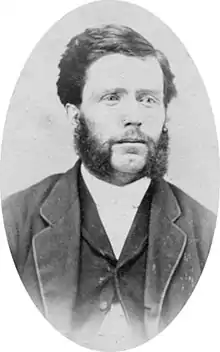Henry S. Finkenbiner
Private Henry S. Finkenbiner (July 29, 1842 – June 3, 1922) was an American soldier who fought in the American Civil War. Finkenbiner received the country's highest award for bravery during combat, the Medal of Honor, for his action at Dingle's Mill in South Carolina on 9 April 1865. He was honored with the award on 30 March 1898.[1]
Henry S. Finkenbiner | |
|---|---|
 | |
| Born | July 29, 1842 North Industry, Ohio, US |
| Died | June 3, 1922 (aged 79) Lagro, Indiana, US |
| Buried | Hopewell Cemetery |
| Allegiance | |
| Service/ | |
| Rank | Private |
| Unit | |
| Awards | |
Biography
Finkenbiner was born in North Industry, Ohio on 29 July 1842 the son of George and Susannah Stands Finkenbiner. He enlisted into the 107th Ohio Infantry. He served as a Corporal in Company D, 107th Ohio Volunteer Infantry Regiment (103rd OVI).
Finkenbiner and the 107th OVI spent their service with the Army of the Potomac until August 1863 when they transferred to the Department of the South and operated there until the end of the war. He was awarded the Medal of Honor for action on April 9, 1865, at Dingles Mill, South Carolina.
After the war he returned to Ohio and in 1868, married Amanda Ellen Stoops Finkenbiner (1848–1882) with whom he had seven children, four girls (two of whom died in childhood) and three boys:
- Dora Emmett Finkenbiner 1869–1940
- George Elmer Finkenbiner 1871–1943
- Ida M Finkenbiner Grindle 1873–1914
- Daisy Nevada Finkenbiner 1875–1877
- John Stands Finkenbiner 1876–1949
- Arthur Clinton Finkenbiner 1879–1965
- Minnie Myrtle Finkenbiner 1882–1893
After her death, he married Nancy Eliza Miller Finkenbiner 1858–1911 with whom he had a son:
- Walter Howard Finkenbiner 1886–1931
He received his Medal of Honor on March 30, 1898.
In 1911, his second wife, Nancy, passed away, and he married a third time to a widow, Lorane Smith Myer Finkenbiner, 1843–1917. Widowed a third time in 1917, he died on 3 June 1922 having outlived his wives and four of his children. His remains are interred at the Hopewell Cemetery in Indiana.
Medal of Honor citation
The President of the United States of America, in the name of Congress, takes pleasure in presenting the Medal of Honor to Private Henry S. Finkenbiner, United States Army, for extraordinary heroism on 9 April 1865, while serving with Company D, 107th Ohio Infantry, in action at Dingle's Mill, South Carolina. While on the advance skirmish line and within direct and close fire of the enemy's artillery, Private Finkenbiner crossed the mill race on a burning bridge and ascertained the enemy's position.[1][2][3][4][5]
Notes
References
- Subcommittee on Veterans' Affairs, United States. Congress. Senate. Committee on Labor and Public Welfare (1968). Edward M Kennedy, Chairman (ed.). Medal of Honor, 1863-1968 : "In the Name of the Congress of the United States". Committee print (United States. Congress), 90th Congress, 2nd session. Washington DC: U.S. Government Printing Office. p. 1087. OCLC 1049691780.
- U.S. War Department (1880). The War of the Rebellion: A Compilation of the Official Records of the Union and Confederate Armies. Washington, DC: U.S. Government Printing Office. OCLC 857196196.
- "Henry S Finkenbiner - Recipient -". The Hall of Valor Project. Sightline Media Group. 2020. Retrieved 19 May 2020.
- "Henry S Finkenbiner". THE COMPREHENSIVE GUIDE TO THE VICTORIA & GEORGE CROSS. VCOnline. 2020. Retrieved 2 May 2020.
- "FINKENBINER, HENRY S." Congressional Medal of Honor Society. CMOHS. 2014. Retrieved 19 August 2014.
- "Finkenbiner, Henry S - The National Medal of Honor Museum The National Medal of Honor Museum". The National Medal of Honor Museum. The National Medal of Honor Museum Foundation. 2020. Retrieved 19 May 2020.